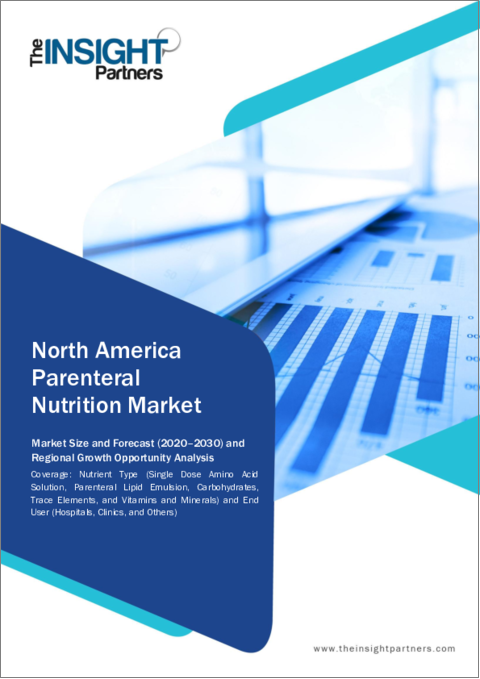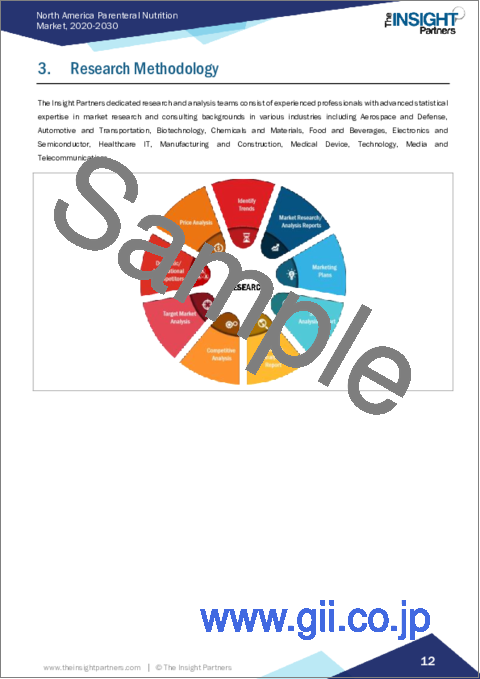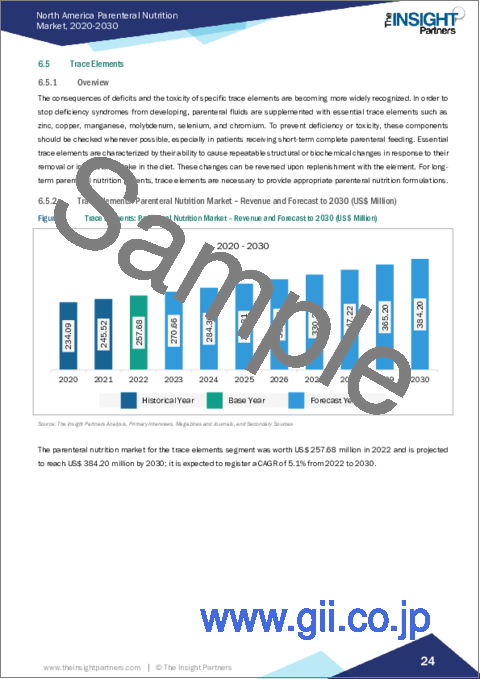|
|
市場調査レポート
商品コード
1562405
北米の非経口栄養剤市場の2030年予測- 地域別分析- 栄養剤タイプ別、エンドユーザー別North America Parenteral Nutrition Market Forecast to 2030 - Regional Analysis - by Nutrient Type and End User |
||||||
|
|||||||
| 北米の非経口栄養剤市場の2030年予測- 地域別分析- 栄養剤タイプ別、エンドユーザー別 |
|
出版日: 2024年07月04日
発行: The Insight Partners
ページ情報: 英文 82 Pages
納期: 即納可能
|
- 全表示
- 概要
- 図表
- 目次
北米の非経口栄養市場は、2022年に30億1,206万米ドルと評価され、2030年には48億531万米ドルに達すると予測され、2022~2030年のCAGRは6.0%を記録すると推定されます。
消化器系疾患の増加が北米の非経口栄養市場を促進
クローン病、腸閉塞、潰瘍性大腸炎、短腸症候群、顕微鏡的大腸炎、胃がんなどは消化器疾患の一例です。2021年1月に発表された「機能性胃腸障害の世界的有病率と負担、ローマ財団世界調査の結果」によると、機能性胃腸障害は世界中の40%以上の人々に影響を及ぼしています。
Global Burden of Disease Study 2019によると、2019年に世界で炎症性腸疾患(IBD)の約490万症例が記録されました。米国(76万2,890人)が最も多い症例数を記録し、有病率はそれぞれ人口10万人当たり245.3人でした。潰瘍性大腸炎とクローン病は、一般的に診断されるIBDの2つです。クローン病は主に消化器系に影響を及ぼす複雑な慢性疾患です。北米と欧州で最も一般的な疾患です。短腸症候群を理解する:2020年に発表された"Current Status and Future Perspectives "によると、短腸症候群(SBS)の有病率は過去40年間で2倍以上に増加しました。有病率は米国で100万人当たり30例、欧州では約1.4例でした。
消化器疾患の患者は、診断試験を受ける前に絶食を求められるため、栄養悪化のリスクが高いです。また、治療上の食事制限や食欲不振による食欲減退、または疾患自体の結果としての栄養要求量の変化により、栄養状態の悪化に直面することもあります。したがって、消化器疾患患者は食物を摂取できないため、医療栄養が推奨されます。さらに、必要な栄養素を補給するために、非経口経路が好まれます。チューブ挿入に適合性を示さない人もいるため、必要なカロリーや栄養素を満たすことが困難な場合もあります。このような場合、非経口栄養は、身体が確実に水分補給され、身体的幸福と機能を維持するために必要なカロリーと他の栄養素の摂取量を満たすために望ましいです。非経口栄養は、がんや慢性疾患など消化管に影響を及ぼす疾患と診断され、患者が栄養必要量を満たせない場合に適応となります。この種の栄養療法は、重度のSBSに罹患しているほとんどの患者にとって、治療法の選択肢として非常に好まれています。したがって、消化管疾患の有病率の増加が非経口栄養市場を牽引しています。
北米の非経口栄養剤市場概要
米国では、がん、心臓病、その他の慢性疾患が障害と死亡の主要原因となっています。National Center for Chronic Disease Prevention and Health Promotionによると、米国では10人に6人が少なくとも1つの慢性疾患と診断されています。また、米国病院協会の推定によると、1億3,300万人が少なくとも1つの慢性疾患を抱えており、その数は2030年までに1億7,000万人に達すると予想されています。2019年1月に発表された"Trends in Parenteral Nutrition "という記事によると、米国では年間平均で約3万4,000人の患者が非経口栄養(PN)を受けています。経腸経管栄養は、小児の350以上の疾患の治療に処方することができます。
米国政府は、イニシアチブを通じて経腸・非経口栄養を人々に知ってもらうことに取り組んでいます。例えば、経管栄養啓発財団(Feeding Tube Awareness Foundation)は、救命医療としての経管栄養の採用に関する認識を高め、経管栄養児の親を支援しています。同財団は2019年2月4日から2019年2月8日まで、毎年恒例の栄養チューブ啓発週間を祝った。さらに、市場参入企業による米国食品医薬品局(FDA)の製品承認の大幅な増加が、予測期間中の市場成長に重要な役割を果たすと考えられます。例えば、2022年3月、フレゼニウス・カビはSMOFlipid脂質注射用乳剤のFDA承認を取得しました。この乳剤は、非経口栄養を必要とするあらゆる年齢の患者を対象とした最初で唯一の4油脂乳剤です。
したがって、医療栄養を必要とする慢性疾患の発生率の増加、非経口栄養の重要性に対する認識を高めるための政府の取り組み、主要企業による戦略的イニシアチブが、米国の非経口栄養市場の成長を支えています。
北米の非経口栄養剤市場の収益と2030年までの予測(金額)
北米の非経口栄養市場のセグメンテーション
北米の非経口栄養市場は、栄養タイプ、エンドユーザー、国に基づいてセグメント化されます。栄養タイプに基づき、北米の非経口栄養市場は単回投与アミノ酸溶液、非経口脂質エマルジョン、炭水化物、微量元素、ビタミン&ミネラルに分類されます。単回投与アミノ酸溶液セグメントが2022年に最大の市場シェアを占めました。
エンドユーザー別では、北米の非経口栄養市場は病院、クリニック、その他に区分されます。病院セグメントが2022年に最大の市場シェアを占めました。
国別では、北米の非経口栄養市場は米国、カナダ、メキシコに区分されます。2022年の北米の非経口栄養剤市場シェアは米国が独占しました。
ICU Medical Inc、Grifols SA、Pfizer Inc、Otsuka Pharmaceuticals Co Ltd、Baxter International Inc、B Braun SE、Fresenius Kabi AG、Aculife Healthcare Pvt Ltd、Vifor Pharma Management AGは、北米の非経口栄養剤市場で事業を展開する大手企業の一部です。
目次
第1章 イントロダクション
第2章 エグゼクティブサマリー
- 主要な洞察
第3章 調査手法
- 調査範囲
- 2次調査
- 1次調査
第4章 北米の非経口栄養市場-主要産業力学
- 市場促進要因
- 消化器疾患の有病率の上昇
- 栄養不良と早産のケースの急増
- 市場抑制要因
- 非経口栄養システムに関連する機械的、消化管的、代謝的合併症
- 市場機会
- 企業による新製品開発
- 今後の動向
- 栄養製品の処方革新
- 影響分析
第5章 非経口栄養剤市場:北米市場分析
- イントロダクション
- 非経口栄養剤市場の収益(2020~2030年)
第6章 北米の非経口栄養剤市場分析-栄養剤タイプ別
- イントロダクション
- 単回投与アミノ酸溶液
- 非経口脂質エマルジョン
- 炭水化物
- 微量元素
- ビタミンとミネラル
第7章 北米の非経口栄養市場分析-エンドユーザー別
- イントロダクション
- 病院
- クリニック
- その他
第8章 北米の非経口栄養市場:国別分析
- 北米
- 米国
- カナダ
- メキシコ
第9章 業界情勢
第10章 企業プロファイル
- ICU Medical Inc
- Grifols SA
- Pfizer Inc
- Otsuka Pharmaceuticals Co Ltd
- Baxter International Inc
- B Braun SE
- Fresenius Kabi AG
- Vifor Pharma Management AG
- Aculife Healthcare Pvt Ltd
第11章 企業概要付録
List Of Tables
- Table 1. Parenteral Nutrition Market Segmentation
- Table 2. United States: Parenteral Nutrition Market - Revenue and Forecast to 2030(US$ Million) - by Nutrient Type
- Table 3. United States: Parenteral Nutrition Market - Revenue and Forecast to 2030(US$ Million) - by End User
- Table 4. Canada: Parenteral Nutrition Market - Revenue and Forecast to 2030(US$ Million) - by Nutrient Type
- Table 5. Canada: Parenteral Nutrition Market - Revenue and Forecast to 2030(US$ Million) - by End User
- Table 6. Mexico: Parenteral Nutrition Market - Revenue and Forecast to 2030(US$ Million) - by Nutrient Type
- Table 7. Mexico: Parenteral Nutrition Market - Revenue and Forecast to 2030(US$ Million) - by End User
- Table 8. Recent Organic Growth Strategies in the Parenteral Nutrition Market
- Table 9. Glossary of Terms, Parenteral Nutrition Market
List Of Figures
- Figure 1. Parenteral Nutrition Market Segmentation, By Country
- Figure 2. Parenteral Nutrition Market: Key Industry Dynamics
- Figure 3. Parenteral Nutrition Market: Impact Analysis of Drivers and Restraints
- Figure 4. Parenteral Nutrition Market Revenue (US$ Mn), 2020 - 2030
- Figure 5. Parenteral Nutrition Market Share (%) - by Nutrient Type (2022 and 2030)
- Figure 6. Single Dose Amino Acid Solution: Parenteral Nutrition Market - Revenue and Forecast to 2030 (US$ Million)
- Figure 7. Parenteral Lipid Emulsion: Parenteral Nutrition Market - Revenue and Forecast to 2030 (US$ Million)
- Figure 8. Carbohydrates: Parenteral Nutrition Market - Revenue and Forecast to 2030 (US$ Million)
- Figure 9. Trace Elements: Parenteral Nutrition Market - Revenue and Forecast to 2030 (US$ Million)
- Figure 10. Vitamins and Minerals: Parenteral Nutrition Market - Revenue and Forecast to 2030 (US$ Million)
- Figure 11. Parenteral Nutrition Market Share (%) - by End User (2022 and 2030)
- Figure 12. Hospitals: Parenteral Nutrition Market - Revenue and Forecast to 2030 (US$ Million)
- Figure 13. Clinics: Parenteral Nutrition Market - Revenue and Forecast to 2030 (US$ Million)
- Figure 14. Others: Parenteral Nutrition Market - Revenue and Forecast to 2030 (US$ Million)
- Figure 15. North America: Parenteral Nutrition Market, by Key Country - Revenue (2022) (US$ Million)
- Figure 16. North America: Parenteral Nutrition Market Breakdown, by Key Countries, 2022 and 2030 (%)
- Figure 17. United States: Parenteral Nutrition Market - Revenue and Forecast to 2030(US$ Million)
- Figure 18. Canada: Parenteral Nutrition Market - Revenue and Forecast to 2030(US$ Million)
- Figure 19. Mexico: Parenteral Nutrition Market - Revenue and Forecast to 2030(US$ Million)
The North America parenteral nutrition market was valued at US$ 3,012.06 million in 2022 and is expected to reach US$ 4,805.31 million by 2030; it is estimated to record a CAGR of 6.0% from 2022 to 2030.
Rise in Prevalence of Gastrointestinal Diseases Fuels North America Parenteral Nutrition Market
Crohn's disease, bowel obstruction, ulcerative colitis, short bowel syndrome, microscopic colitis, and gastric cancer are a few examples of gastrointestinal diseases. According to the "Worldwide Prevalence and Burden of Functional Gastrointestinal Disorders, Results of Rome Foundation Global Study," published in January 2021, functional gastrointestinal disorders have affected over 40% of people across the globe.
Based on the Global Burden of Disease Study 2019, ~4.9 million cases of inflammatory bowel disease (IBD) were recorded worldwide in 2019. The US (762,890) registered the highest number of cases, with prevalence of 245.3 cases per 100,000 people, respectively. Ulcerative colitis and Crohn's disease are two of the commonly diagnosed IBDs. Crohn's disease is a complex, chronic disorder primarily affecting the digestive system. It is the most common disease in North America and Europe. As per the article titled "Understanding Short Bowel Syndrome: Current Status and Future Perspectives," published in 2020, the prevalence of short bowel syndrome (SBS) has increased by more than twofold in the last 40 years. The prevalence was ~30 cases per million in the US and approximately 1.4 cases per million in Europe.
Patients with gastrointestinal diseases are at an elevated risk of nutritional deterioration as they are asked to fast before undergoing diagnostic tests. They might also face nutritional deterioration due to therapeutic dietary restriction and loss of appetite caused by anorexia or altered nutritional requirements, which can be a result of the disease itself. Hence, medical nutrition is recommended for gastrointestinal disease patients as they are unable to ingest food. Further, the parenteral routes are preferred to provide them with essential nutrients. Some people might not show compatibility with tube insertion, which makes meeting their calorie and nutrient needs difficult. In such cases, parenteral nutrition is preferred to ensure their bodies remain hydrated and meet the calorie and other nutrient intake required to maintain physical well-being and function. Parenteral nutrition is indicated when patients cannot meet their nutritional needs as they are diagnosed with diseases such as cancer and chronic diseases, which affect the gastrointestinal tract. This type of nutrition is highly preferred as a therapy option for most patients suffering from severe SBS. Therefore, the growing prevalence of gastrointestinal diseases drives the parenteral nutrition market.
North America Parenteral Nutrition Market Overview
Cancer, heart disease, and other chronic diseases are the major causes of disability and death in the US. Per the National Center for Chronic Disease Prevention and Health Promotion, 6 in 10 people in the country are diagnosed with at least one chronic disease. Additionally, the American Hospital Association estimates that ~133 million people have at least one chronic disease, and that number is expected to reach 170 million by 2030. According to an article titled "Trends in Parenteral Nutrition," published in January 2019; on average, ~34,000 patients receive parenteral nutrition (PN) annually in the US. Enteral tube feeding can be prescribed for treating more than 350 disease conditions in children.
The US government is working on making people aware of enteral and parenteral nutrition through initiatives. For instance, the Feeding Tube Awareness Foundation creates awareness about the adoption of feeding tubes as a lifesaving medical intervention and helps parents of tube-fed children. The foundation celebrated the annual Feeding Tube Awareness Week from February 4, 2019, to February 8, 2019. In addition, a significant rise in US Food and Drug Administration (FDA) approvals of products by market players is likely to play a key role in the market growth during the forecast period. For instance, in March 2022, Fresenius Kabi received FDA approval for its SMOFlipid lipid injectable emulsion. The emulsion is the first and only four-oil lipid emulsion for patients of all ages requiring parenteral nutrition.
Therefore, the growing incidence of chronic diseases requiring medical nutrition, government efforts to raise awareness about the importance of parenteral nutrition, and strategic initiatives by key players support the growth of the parenteral nutrition market in the United States.
North America Parenteral Nutrition Market Revenue and Forecast to 2030 (US$ Million)
North America Parenteral Nutrition Market Segmentation
The North America parenteral nutrition market is segmented based on nutrient type, end user, and country. Based on nutrient type, the North America parenteral nutrition market is categorized into single dose amino acid solution, parenteral lipid emulsion, carbohydrates, trace elements, and vitamins & minerals. The single dose amino acid solution segment held the largest market share in 2022.
By end user, the North America parenteral nutrition market is segmented into hospitals, clinics, and others. The hospitals segment held the largest market share in 2022.
Based on country, the North America parenteral nutrition market is segmented into the US, Canada, and Mexico. The US dominated the North America parenteral nutrition market share in 2022.
ICU Medical Inc, Grifols SA, Pfizer Inc, Otsuka Pharmaceuticals Co Ltd, Baxter International Inc, B Braun SE, Fresenius Kabi AG, Aculife Healthcare Pvt Ltd, and Vifor Pharma Management AG are some of the leading players operating in the North America parenteral nutrition market.
Table Of Contents
1. Introduction
- 1.1 The Insight Partners Research Report Guidance
- 1.2 Market Segmentation
2. Executive Summary
- 2.1 Key Insights
3. Research Methodology
- 3.1 Coverage
- 3.2 Secondary Research
- 3.3 Primary Research
4. North America Parenteral Nutrition Market - Key Industry Dynamics
- 4.1 Market Drivers
- 4.1.1 Rise in Prevalence of Gastrointestinal Diseases
- 4.1.2 Surge in Cases of Malnutrition and Premature Births
- 4.2 Market Restraints
- 4.2.1 Mechanical, Gastrointestinal, and Metabolic Complications Associated with Parenteral Feeding Systems
- 4.3 Market Opportunities
- 4.3.1 New Product Developments by Companies
- 4.4 Future Trends
- 4.4.1 Innovation in Formulations of Nutrition Products
- 4.5 Impact Analysis
5. Parenteral Nutrition Market - North America Market Analysis
- 5.1 Overview
- 5.2 Parenteral Nutrition Market Revenue (US$ Mn), 2020 - 2030
6. North America Parenteral Nutrition Market Analysis - by Nutrient Type
- 6.1 Overview
- 6.2 Single Dose Amino Acid Solution
- 6.2.1 Overview
- 6.2.2 Single Dose Amino Acid Solution: Parenteral Nutrition Market - Revenue and Forecast to 2030 (US$ Million)
- 6.3 Parenteral Lipid Emulsion
- 6.3.1 Overview
- 6.3.2 Parenteral Lipid Emulsion: Parenteral Nutrition Market - Revenue and Forecast to 2030 (US$ Million)
- 6.4 Carbohydrates
- 6.4.1 Overview
- 6.4.2 Carbohydrates: Parenteral Nutrition Market - Revenue and Forecast to 2030 (US$ Million)
- 6.5 Trace Elements
- 6.5.1 Overview
- 6.5.2 Trace Elements: Parenteral Nutrition Market - Revenue and Forecast to 2030 (US$ Million)
- 6.6 Vitamins and Minerals
- 6.6.1 Overview
- 6.6.2 Vitamins and Minerals: Parenteral Nutrition Market - Revenue and Forecast to 2030 (US$ Million)
7. North America Parenteral Nutrition Market Analysis - by End User
- 7.1 Overview
- 7.2 Hospitals
- 7.2.1 Overview
- 7.2.2 Hospitals: Parenteral Nutrition Market - Revenue and Forecast to 2030 (US$ Million)
- 7.3 Clinics
- 7.3.1 Overview
- 7.3.2 Clinics: Parenteral Nutrition Market - Revenue and Forecast to 2030 (US$ Million)
- 7.4 Others
- 7.4.1 Overview
- 7.4.2 Others: Parenteral Nutrition Market - Revenue and Forecast to 2030 (US$ Million)
8. North America Parenteral Nutrition Market - Country Analysis
- 8.1 North America: Parenteral Nutrition Market
- 8.1.1 North America: Parenteral Nutrition Market - Revenue and Forecast Analysis - by Country
- 8.1.1.1 United States: Parenteral Nutrition Market - Revenue and Forecast to 2030 (US$ Million)
- 8.1.1.1.1 Overview
- 8.1.1.1.2 United States: Parenteral Nutrition Market - Revenue and Forecast to 2030 (US$ Million)
- 8.1.1.1.3 United States: Parenteral Nutrition Market Breakdown, by Nutrient Type
- 8.1.1.1.4 United States: Parenteral Nutrition Market Breakdown, by End User
- 8.1.1.2 Canada: Parenteral Nutrition Market - Revenue and Forecast to 2030 (US$ Million)
- 8.1.1.2.1 Overview
- 8.1.1.2.2 Canada: Parenteral Nutrition Market - Revenue and Forecast to 2030 (US$ Million)
- 8.1.1.2.3 Canada: Parenteral Nutrition Market Breakdown, by Nutrient Type
- 8.1.1.2.4 Canada: Parenteral Nutrition Market Breakdown, by End User
- 8.1.1.3 Mexico: Parenteral Nutrition Market - Revenue and Forecast to 2030 (US$ Million)
- 8.1.1.3.1 Overview
- 8.1.1.3.2 Mexico: Parenteral Nutrition Market - Revenue and Forecast to 2030 (US$ Million)
- 8.1.1.3.3 Mexico: Parenteral Nutrition Market Breakdown, by Nutrient Type
- 8.1.1.3.4 Mexico: Parenteral Nutrition Market Breakdown, by End User
- 8.1.1.1 United States: Parenteral Nutrition Market - Revenue and Forecast to 2030 (US$ Million)
- 8.1.1 North America: Parenteral Nutrition Market - Revenue and Forecast Analysis - by Country
9. Industry Landscape
- 9.1 Overview
- 9.1.1 Overview
10. Company Profiles
- 10.1 ICU Medical Inc
- 10.1.1 Key Facts
- 10.1.2 Business Description
- 10.1.3 Products and Services
- 10.1.4 Financial Overview
- 10.1.5 SWOT Analysis
- 10.1.6 Key Developments
- 10.2 Grifols SA
- 10.2.1 Key Facts
- 10.2.2 Business Description
- 10.2.3 Products and Services
- 10.2.4 Financial Overview
- 10.2.5 SWOT Analysis
- 10.2.6 Key Developments
- 10.3 Pfizer Inc
- 10.3.1 Key Facts
- 10.3.2 Business Description
- 10.3.3 Products and Services
- 10.3.4 Financial Overview
- 10.3.5 SWOT Analysis
- 10.3.6 Key Developments
- 10.4 Otsuka Pharmaceuticals Co Ltd
- 10.4.1 Key Facts
- 10.4.2 Business Description
- 10.4.3 Products and Services
- 10.4.4 Financial Overview
- 10.4.5 SWOT Analysis
- 10.4.6 Key Developments
- 10.5 Baxter International Inc
- 10.5.1 Key Facts
- 10.5.2 Business Description
- 10.5.3 Products and Services
- 10.5.4 Financial Overview
- 10.5.5 SWOT Analysis
- 10.5.6 Key Developments
- 10.6 B Braun SE
- 10.6.1 Key Facts
- 10.6.2 Business Description
- 10.6.3 Products and Services
- 10.6.4 Financial Overview
- 10.6.5 SWOT Analysis
- 10.6.6 Key Developments
- 10.7 Fresenius Kabi AG
- 10.7.1 Key Facts
- 10.7.2 Business Description
- 10.7.3 Products and Services
- 10.7.4 Financial Overview
- 10.7.5 SWOT Analysis
- 10.7.6 Key Developments
- 10.8 Vifor Pharma Management AG
- 10.8.1 Key Facts
- 10.8.2 Business Description
- 10.8.3 Products and Services
- 10.8.4 Financial Overview
- 10.8.5 SWOT Analysis
- 10.8.6 Key Developments
- 10.9 Aculife Healthcare Pvt Ltd
- 10.9.1 Key Facts
- 10.9.2 Business Description
- 10.9.3 Products and Services
- 10.9.4 Financial Overview
- 10.9.5 SWOT Analysis
- 10.9.6 Key Developments
11. Appendix
- 11.1 About The Insight Partners
- 11.2 Glossary of Terms





